Coal Mine Safety Accidents, Environmental Regulation and Economic Development—An Empirical Study of PVAR Based on Ten Major Coal Provinces in China
Abstract
:1. Introduction
2. Literature Review
2.1. Relationship between Economic Development and Coal Mine Accidents
2.2. Relationship between Environmental Regulation and Coal Mine Accidents
2.3. Review
3. Methodology
3.1. Econometric Model
3.2. Variable Description
- (1)
- Coal mine accidents
- (2)
- Economic development
- (3)
- Environmental regulation
3.3. Data Sources
4. Empirical Analysis
4.1. Unit Root Test
4.2. Determining the Lag Order
4.3. Robustness Test
4.4. GMM Estimation of the Model
4.5. Impulse Response
4.6. Variance Decomposition
5. Discussion
6. Conclusions
- (1)
- From the static development between coal mine accidents, environmental regulation and economic development in China’s ten major coal provinces, the three variables have achieved coordinated development. Only the impact mechanism of environmental regulation on economic development is unreasonable. The impact coefficient of coal mine accidents on environmental regulation is 0.04; coal mine accidents promote environmental regulation. The impact coefficient of environmental regulation on coal mine accidents is −0.176. Environmental regulation inhibits coal mine accidents. The impact coefficient of economic development on environmental regulation is 0.791; economic development strongly promotes environmental regulation. The impact coefficient of environmental regulation on economic development is −0.0015; environmental regulation has a weak inhibitory effect on economic development. The impact coefficient of coal mine accidents on economic development is −0.015; coal mine accidents slightly inhibit economic development. The impact coefficient of economic development on coal mine accidents is −1.035; economic development strongly inhibits coal mine accidents.
- (2)
- The dynamic development relationship between the three variables, coal mine accidents, environmental regulation and economic development, is good as a whole but needs to be optimized. There is a strong dynamic response relationship between environmental regulation and coal mine accidents. When environmental regulation inhibits (promotes) coal mine accidents, the accidents will promote (inhibit) environmental regulation, but on the whole, the impact of environmental regulation on accidents shows a decreasing volatility trend, and the impact of coal mine accidents on environmental regulation shows a rising volatility trend. There is a short-term positive interaction between economic development and environmental regulation, but the interaction relationship between them decreases with time. The dynamic development relationship between coal mine accidents and economic development has been relatively reasonable. Ten major coal provinces have shown that economic development has a long-term inhibitory effect on coal mine accidents, which conforms to the theory that stable economic development will inhibit coal mine accidents. The negative impact of coal mine accidents on economic development has gradually decreased to 0.
Author Contributions
Funding
Institutional Review Board Statement
Informed Consent Statement
Data Availability Statement
Conflicts of Interest
References
- Song, L. Dynamic Econometric Analysis of the Relativity between Accident Disaster and Economic Growth and Its Application. Ph.D. Thesis, China University of Mining and Technology, Beijing, China, 2010. [Google Scholar]
- Li, S.; He, C.; Chen, C.Y.; Wang, W.C. The Theory and Practice of Double Prevention Mechanism of Production and Management Unit Safety; Chinese Mining University Press: Xuzhou, China, 2021. [Google Scholar]
- Tian, S.C. Safety Economics; China University of Mining and Technology Press: Xuzhou, China, 2017. [Google Scholar]
- Huang, S.H.; Zhou, X.Q.; Zhang, B.C. Multiple regression analysis on occupational safety and economic and social development. J. China Coal Soc. 2005, 5, 38–42. [Google Scholar]
- Liu, T.; Zhong, M.; Xing, J. Industrial accidents: Challenges for China’s economic and social development. Saf. Sci. 2005, 43, 503–522. [Google Scholar] [CrossRef]
- Hong, C.; Qun, F. The Cryptic Regional Inequality in China’s Economic Development: The Life Cost Sunk in Coal Mine Accidents. Disaster Adv. 2012, 5, 1591–1596. [Google Scholar]
- Zhong, X.H. On the Negative Correlation between Mortality and Output: Effects of Shutdown Policy in China’s Coal Industry. China J. Econ. 2011, 5, 67–103. [Google Scholar]
- Bai, C.E.; Wang, X.; Zhong, X.H. Regulation and Property Right: Effect of China’s Coalmine Shutdown Policy on Work Safety. China Soft Sci. 2011, 10, 12–26. [Google Scholar]
- Xiang, L.; Wang, C. Study on the interactive relationship between environmental regulation, coal industry employment and coal mine safety. China Min. Mag. 2018, 27, 26–29. [Google Scholar]
- Love, I.; Zicchino, L. Financial development and dynamic investment behavior: Evidence from panel var. Q. Rev. Econ. Financ. 2006, 46, 190–210. [Google Scholar] [CrossRef]
- Peng, X. Strategic interaction of environmental regulation and green productivity growth in China: Green innovation or pollution refuge? Sci. Total Environ. 2020, 732, 139200. [Google Scholar] [CrossRef] [PubMed]
- Ouyang, X.L.; Zhang, J.H.; Du, G. Environmental regulation and green technological innovation: Impact mechanism analysis and spatial spillover effects. Chin. J. Manag. Sci. 2022, 1–12. [Google Scholar]
- Li, L.N.; Li, L.H. Impact of Environmental Regulation on Economic Development—Based on the Analysis of Provincial Panel Data. J. Sichuan Norm. Univ. 2019, 46, 43–52. [Google Scholar]
- Du, W.; Li, M. Can environmental regulation promote the governance of excess capacity in China’s energy sector? The market exit of zombie enterprises. J. Clean. Prod. 2019, 207, 306–316. [Google Scholar] [CrossRef]
- Esterhuizen, G.S.; Guertunca, R.G. Coal mine safety achievements in the USA and the contribution of NIOSH research. J. South. Afr. Inst. Min. Metall. 2006, 106, 813–820. [Google Scholar]
- Fan, B.; Guo, T.; Xu, R.; Dong, W. Evolutionary game research on the impact of environmental regulation on overcapacity in coal industry. Math. Probl. Eng. 2021, 2021, 5558112. [Google Scholar] [CrossRef]
- Pan, X.; Ai, B.; Li, C.; Pan, X.; Yan, Y. Dynamic relationship among environmental regulation, technological innovation and energy efficiency based on large scale provincial panel data in China. Technol. Forecast. Soc. Change 2019, 144, 428–435. [Google Scholar] [CrossRef]
- Li, X.; Yao, X. Can energy supply-side and demand-side policies for energy saving and emission reduction be synergistic? A simulated study on China’s coal capacity cut and carbon tax. Energy Policy 2020, 138, 111232. [Google Scholar] [CrossRef]
- Xiong, Y. Research on the Relationship Between Environmental Regulation and Economic Growth Based on the Provincial Data in China. China Popul. Resour. Environ. 2011, 21, 126–131. [Google Scholar]
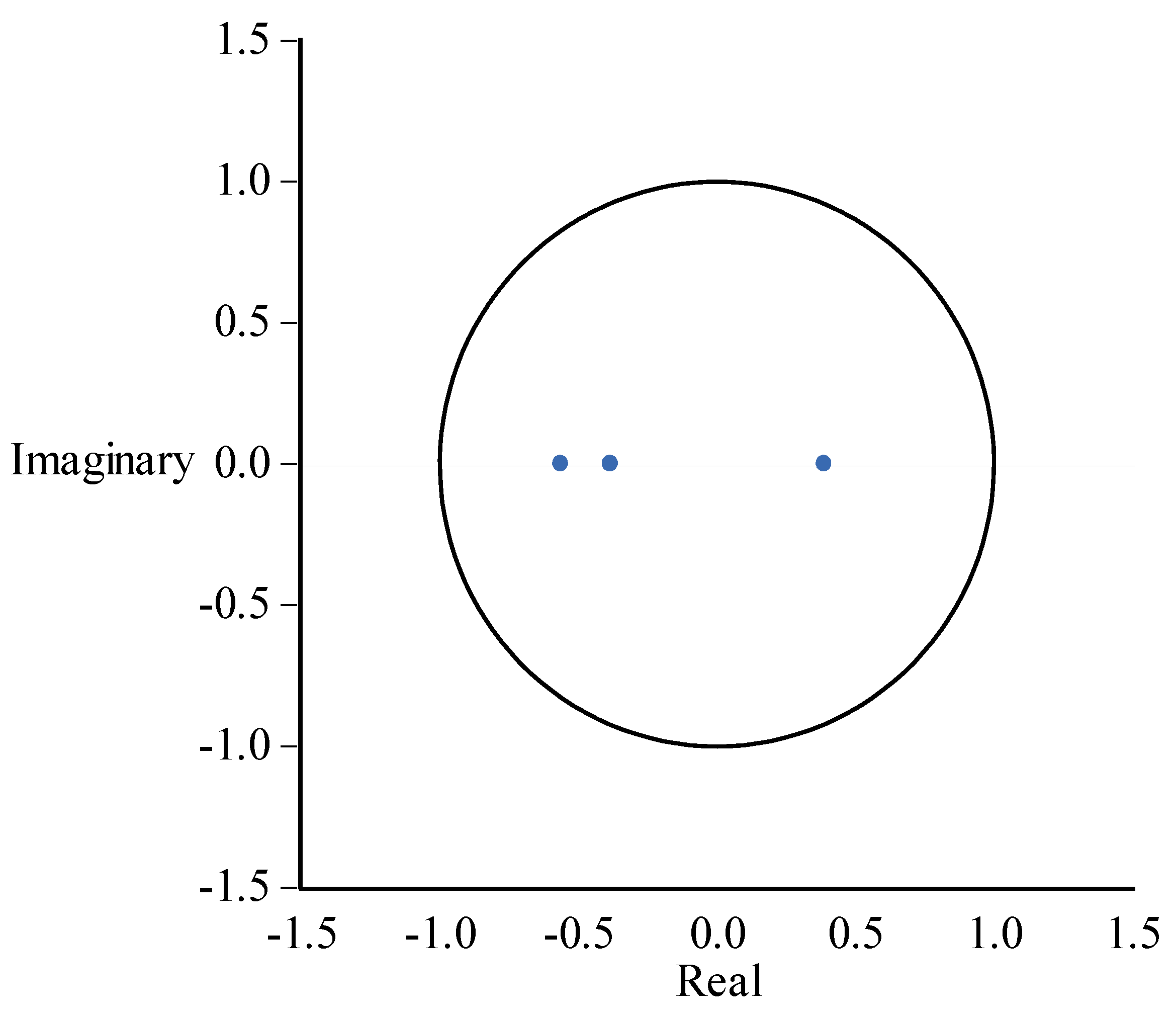
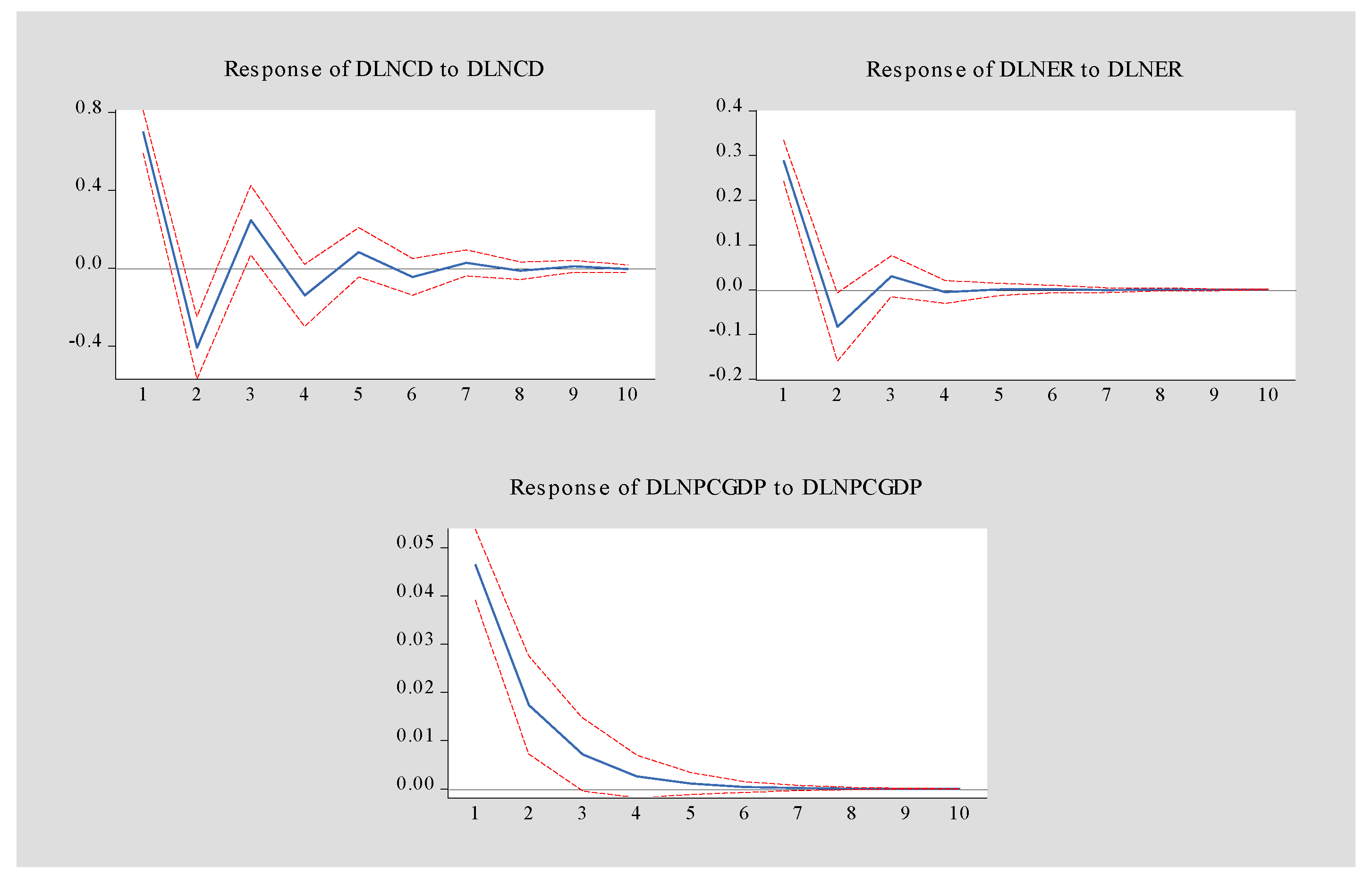
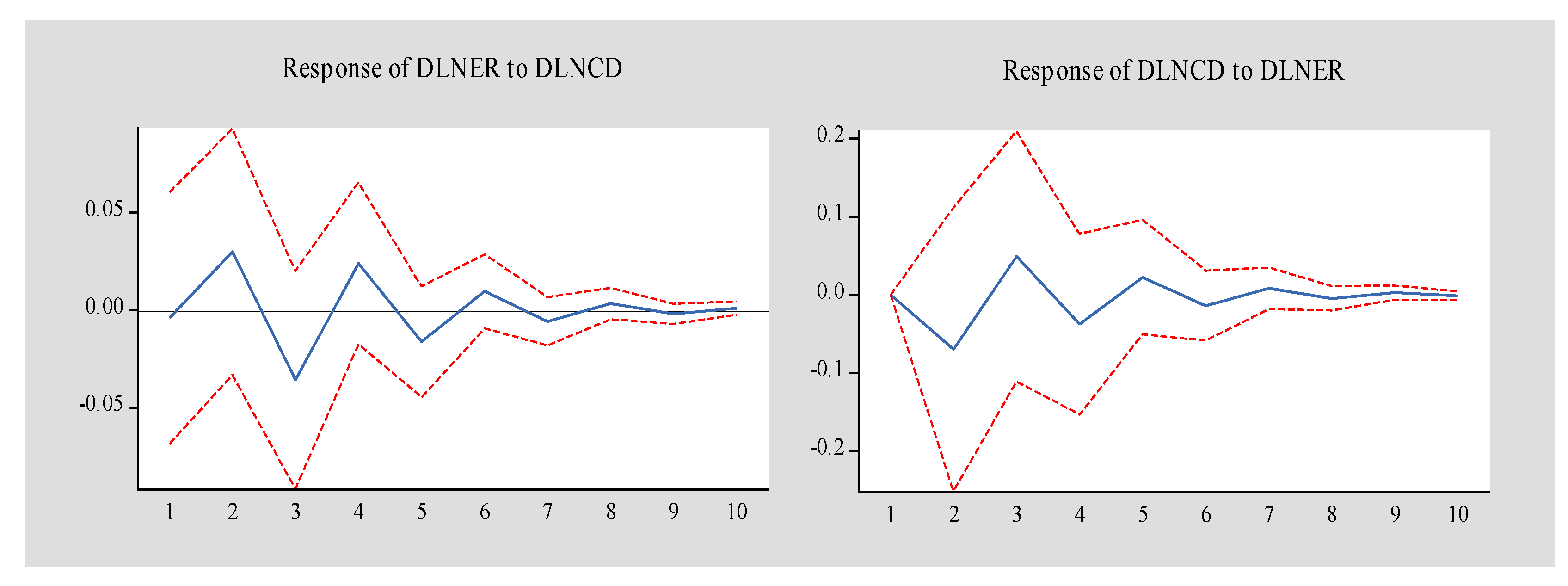
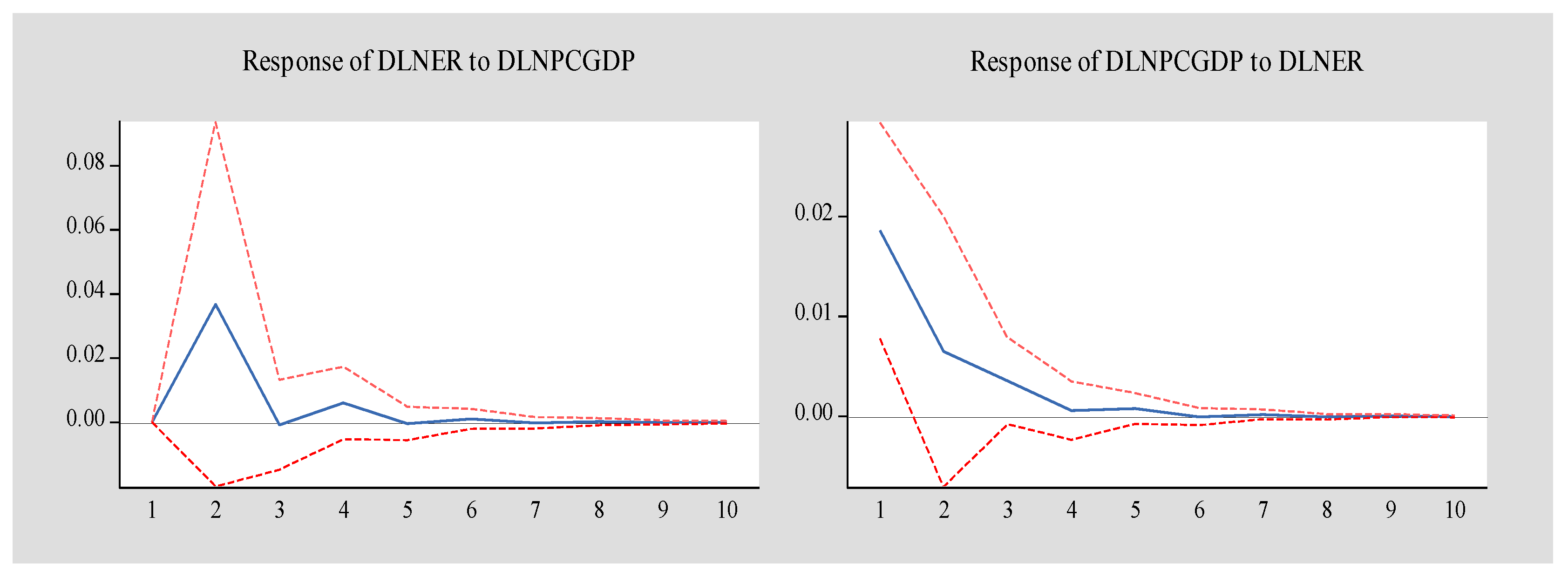
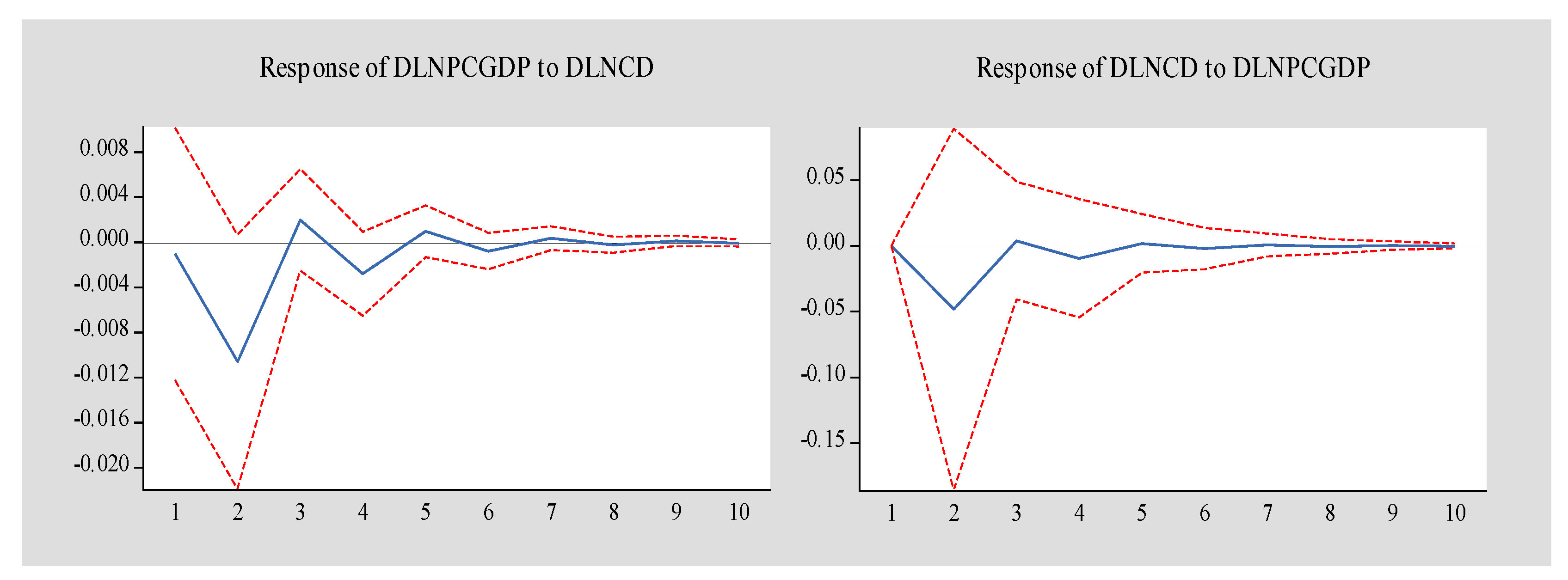
| Variables | Number of Samples | Mean | Std. Dev. | Max | Min |
|---|---|---|---|---|---|
| CD | 100 | 0.234 | 0.322 | 0.009 | 1.838 |
| ER | 100 | 0.332 | 0.142 | 0.058 | 0.819 |
| PCGDP | 100 | 44,231.53 | 15,305.26 | 16,413 | 76,267 |
| Horizontal Data | First Difference Data | |||||
|---|---|---|---|---|---|---|
| Variable | LnCD | LnER | LnPCGDP | DLnCD | DLnER | DLnPCGDP |
| p | 0.0014 | 0.1235 | 0.022 | 0 | 0 | 0.0001 |
| Test results | Stationary | Non-stationary data | Stationary | Stationary | Stationary | Stationary |
| Lag | LR | FPE | AIC | SC | HQ |
|---|---|---|---|---|---|
| 0 | NA | 0.000211 | 0.051194 | 0.155911 | 0.092155 |
| 1 | 44.04633 * | 0.000130 * | −0.435347 * | −0.016479 * | 0.271505 * |
| 2 | 8.85349 | 0.000149 | −0.302394 | 0.430626 | −0.01567 |
| 3 | 13.09594 | 0.000156 | −0.264313 | 0.782859 | 0.145293 |
| DLNCD (a) | DLNEC (b) | DLNPCGDP (c) | |
|---|---|---|---|
| DLNCD (−1) | −0.587197 | 0.042065 | −0.014575 |
| [−5.68087] | [0.98721] | [−1.97144] | |
| DLNEC (−1) | −0.175589 | −0.338079 | −0.001473 |
| [−0.55404] | [−2.58778] | [−0.06497] | |
| DLNPCGDP (−1) | −1.034829 | 0.790727 | 0.372649 |
| [−0.70275] | [1.30263] | [3.53821] |
| DLNCD | DLNEC | DLNPCGDP | |||||||
|---|---|---|---|---|---|---|---|---|---|
| Period | DLNCD | DLNEC | DLNPCGDP | DLNCD | DLNEC | DLNPCGDP | DLNCD | DLNEC | DLNPCGDP |
| 1 | 100.00 | 0.00 | 0.00 | 0.02 | 99.98 | 0.00 | 0.04 | 13.78 | 86.18 |
| 2 | 98.92 | 0.73 | 0.35 | 0.99 | 97.55 | 1.46 | 3.82 | 13.09 | 83.09 |
| 3 | 98.68 | 1.00 | 0.32 | 2.32 | 96.26 | 1.43 | 3.86 | 13.22 | 82.92 |
| 4 | 98.52 | 1.16 | 0.32 | 2.90 | 95.64 | 1.46 | 4.10 | 13.17 | 82.73 |
| 5 | 98.46 | 1.22 | 0.32 | 3.17 | 95.37 | 1.45 | 4.13 | 13.17 | 82.70 |
| 6 | 98.44 | 1.24 | 0.32 | 3.27 | 95.28 | 1.45 | 4.15 | 13.17 | 82.68 |
| 7 | 98.43 | 1.25 | 0.32 | 3.30 | 95.25 | 1.45 | 4.15 | 13.17 | 82.68 |
| 8 | 98.43 | 1.25 | 0.32 | 3.31 | 95.24 | 1.45 | 4.15 | 13.17 | 82.68 |
| 9 | 98.43 | 1.25 | 0.32 | 3.32 | 95.23 | 1.45 | 4.15 | 13.17 | 82.68 |
| 10 | 98.43 | 1.25 | 0.32 | 3.32 | 95.23 | 1.45 | 4.15 | 13.17 | 82.68 |
Publisher’s Note: MDPI stays neutral with regard to jurisdictional claims in published maps and institutional affiliations. |
© 2022 by the authors. Licensee MDPI, Basel, Switzerland. This article is an open access article distributed under the terms and conditions of the Creative Commons Attribution (CC BY) license (https://creativecommons.org/licenses/by/4.0/).
Share and Cite
Lu, C.; Li, S.; Xu, K.; Liu, J. Coal Mine Safety Accidents, Environmental Regulation and Economic Development—An Empirical Study of PVAR Based on Ten Major Coal Provinces in China. Sustainability 2022, 14, 14334. https://doi.org/10.3390/su142114334
Lu C, Li S, Xu K, Liu J. Coal Mine Safety Accidents, Environmental Regulation and Economic Development—An Empirical Study of PVAR Based on Ten Major Coal Provinces in China. Sustainability. 2022; 14(21):14334. https://doi.org/10.3390/su142114334
Chicago/Turabian StyleLu, Cheng, Shuang Li, Kun Xu, and Jiao Liu. 2022. "Coal Mine Safety Accidents, Environmental Regulation and Economic Development—An Empirical Study of PVAR Based on Ten Major Coal Provinces in China" Sustainability 14, no. 21: 14334. https://doi.org/10.3390/su142114334
APA StyleLu, C., Li, S., Xu, K., & Liu, J. (2022). Coal Mine Safety Accidents, Environmental Regulation and Economic Development—An Empirical Study of PVAR Based on Ten Major Coal Provinces in China. Sustainability, 14(21), 14334. https://doi.org/10.3390/su142114334







